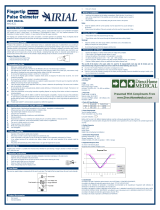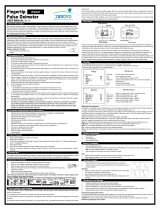
Please don’t measure this device with function test paper for the device’s related information.
1.3 Attentions
Keep the oximeter away from dust, vibration, corrosive substances, explosive materials, high temperature and
moisture.
If the oximeter gets wet, please stop operating it.
When it is carried from cold environment to warm or humid environment, please do not use it immediately.
DO NOT operate keys on front panel with sharp materials.
High temperature or high pressure steam disinfection of the oximeter is not permitted. Refer to User Manual in
the relative chapter for instructions of cleaning and disinfection.
Do not have the oximeter immerged in liquid. When it needs cleaning, please wipe its surface with medical
alcohol by soft material. Do not spray any liquid on the device directly.
When cleaning the device with water, the temperature should be lower than 60°C.
As to the ngers which are too thin or too cold, it would probably affect the normal measure of the users’ SpO
2
,
and pulse rate, please clip the thick nger such as thumb and middle nger deeply enough into the probe.
Do not use the device on infant or neonatal user.
The product is suitable for children above four years old and adults (Weight should be between 15kg to 110kg).
The device may not work for all users. If you are unable to achieve stable readings, discontinue use.
The update period of data is less than 5 seconds, which is changeable according to different individual pulse rate.
The waveform is normalized. Please read the measured value when the waveform on screen is equably and
steady-going. Here this measured value is optimal value. And the waveform at the moment is the standard one.
If some abnormal conditions appear on the screen during test process, pull out the nger and reinsert to restore
normal use.
The device has normal useful life for three years since the rst electried use.
The lanyard attached to the product is made from Non-allergy material, if particular group are sensitive to the
lanyard, stop using it. In addition, pay attention to the use of the lanyard, do not wear it around the neck avoiding
cause harm to the user.
The instrument has a visible low-voltage indicator, please change the batteries when the voltage is low.
The instrument dose not have low-voltage alarm function. Do not use the device in situations where alarms are
required.























